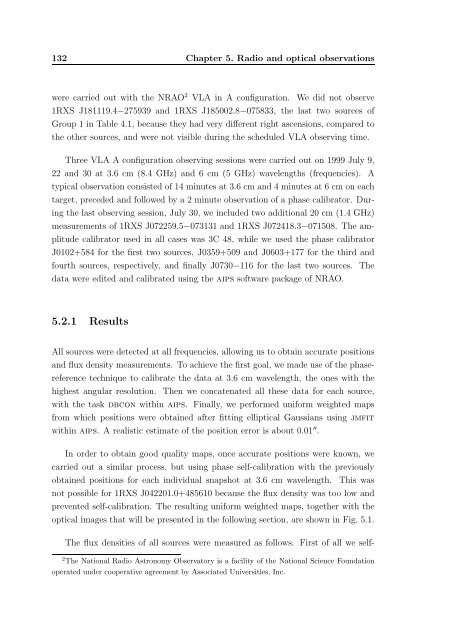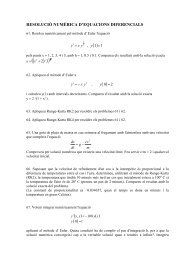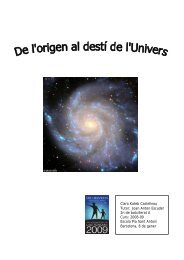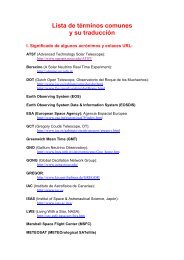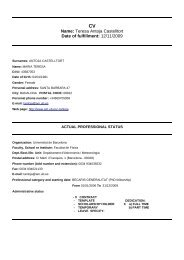Universitat de - Departament d'Astronomia i Meteorologia ...
Universitat de - Departament d'Astronomia i Meteorologia ...
Universitat de - Departament d'Astronomia i Meteorologia ...
You also want an ePaper? Increase the reach of your titles
YUMPU automatically turns print PDFs into web optimized ePapers that Google loves.
132 Chapter 5. Radio and optical observations<br />
were carried out with the NRAO 2 VLA in A configuration. We did not observe<br />
1RXS J181119.4−275939 and 1RXS J185002.8−075833, the last two sources of<br />
Group 1 in Table 4.1, because they had very different right ascensions, compared to<br />
the other sources, and were not visible during the scheduled VLA observing time.<br />
Three VLA A configuration observing sessions were carried out on 1999 July 9,<br />
22 and 30 at 3.6 cm (8.4 GHz) and 6 cm (5 GHz) wavelengths (frequencies). A<br />
typical observation consisted of 14 minutes at 3.6 cm and 4 minutes at 6 cm on each<br />
target, prece<strong>de</strong>d and followed by a 2 minute observation of a phase calibrator. Dur-<br />
ing the last observing session, July 30, we inclu<strong>de</strong>d two additional 20 cm (1.4 GHz)<br />
measurements of 1RXS J072259.5−073131 and 1RXS J072418.3−071508. The am-<br />
plitu<strong>de</strong> calibrator used in all cases was 3C 48, while we used the phase calibrator<br />
J0102+584 for the first two sources, J0359+509 and J0603+177 for the third and<br />
fourth sources, respectively, and finally J0730−116 for the last two sources. The<br />
data were edited and calibrated using the aips software package of NRAO.<br />
5.2.1 Results<br />
All sources were <strong>de</strong>tected at all frequencies, allowing us to obtain accurate positions<br />
and flux <strong>de</strong>nsity measurements. To achieve the first goal, we ma<strong>de</strong> use of the phase-<br />
reference technique to calibrate the data at 3.6 cm wavelength, the ones with the<br />
highest angular resolution. Then we concatenated all these data for each source,<br />
with the task dbcon within aips. Finally, we performed uniform weighted maps<br />
from which positions were obtained after fitting elliptical Gaussians using jmfit<br />
within aips. A realistic estimate of the position error is about 0.01 ′′ .<br />
In or<strong>de</strong>r to obtain good quality maps, once accurate positions were known, we<br />
carried out a similar process, but using phase self-calibration with the previously<br />
obtained positions for each individual snapshot at 3.6 cm wavelength. This was<br />
not possible for 1RXS J042201.0+485610 because the flux <strong>de</strong>nsity was too low and<br />
prevented self-calibration. The resulting uniform weighted maps, together with the<br />
optical images that will be presented in the following section, are shown in Fig. 5.1.<br />
The flux <strong>de</strong>nsities of all sources were measured as follows. First of all we self-<br />
2 The National Radio Astronomy Observatory is a facility of the National Science Foundation<br />
operated un<strong>de</strong>r cooperative agreement by Associated Universities, Inc.


